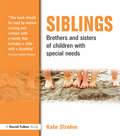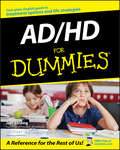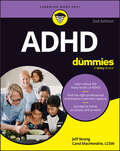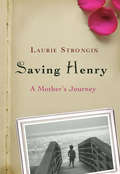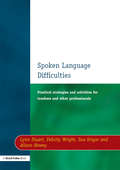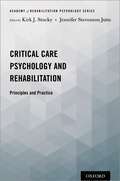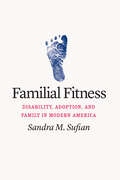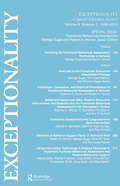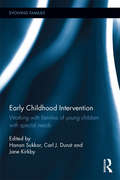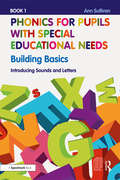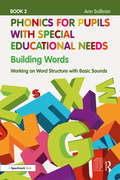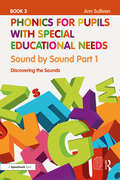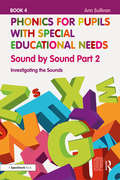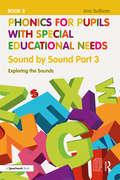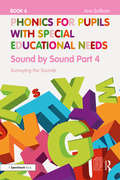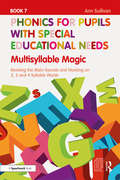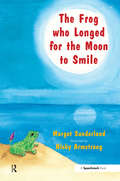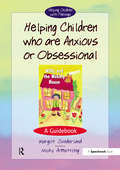- Table View
- List View
Siblings: Brothers and Sisters of Children with Special Needs
by Kate StrohmThe siblings of children with special needs are often the overlooked ones in families struggling to cope. Kate Strohm is an experienced health professional and journalist who has sister with cerebral palsy. In this book she shares the story of her journey from confusion and distress to understanding and acceptance. She provides a forum for other siblings to describe their own journeys. Kate also provides strategies that siblings themselves, parents and practitioner can use to support the brothers and sisters of children with special.
AD / HD For Dummies
by Jeff Strong Michael O. FlanaganSound advice for parents whose kids have trouble concentrating According to the National Institutes of Health, an estimated five to ten percent of children suffer from Attention Deficit Disorder (ADD) or Attention Deficit Hyperactivity Disorder (ADHD). This book provides answers for parents of children who may have either condition, as well as for adult sufferers. Written in a friendly, easy-to-understand style, it helps people recognize and understand ADD and ADHD symptoms and offers an authoritative, balanced overview of both drug and non-drug therapies.
ADHD For Dummies
by Jeff Strong Carol MacHendrieDemystify ADHD with simple explanations of the basics and the latest research Attention deficit hyperactivity disorder (ADHD) is one of the most globally prevalent neurodevelopmental disorders. ADHD For Dummies explores living a healthy and fulfilling life with ADHD, from seeking diagnosis to choosing the right treatment path for you or your loved one. You’ll read about the latest in ADHD research, equipping you with valuable knowledge as you care for a child with ADHD or explore your own ADHD symptoms as an adult. This book provides the answers you need on how to deal with day-to-day challenges at home, school, and work, and how to find support and counseling. With appropriate management, anyone can live a great life with ADHD. Learn what ADHD is—and what it isn’t Get up to date with the latest information on ADHD, including medications and non-medical treatments Find the right professional to help you get the support you or your children needThis is the perfect Dummies guide for both parents of children with ADHD and adults with ADHD looking to learn more. Teachers, counselors, and therapists—this is also a great resource to educate yourself and your clients.
ADHD For Dummies
by Jeff Strong Carol MacHendrieDemystify ADHD with simple explanations of the basics and the latest research Attention deficit hyperactivity disorder (ADHD) is one of the most globally prevalent neurodevelopmental disorders. ADHD For Dummies explores living a healthy and fulfilling life with ADHD, from seeking diagnosis to choosing the right treatment path for you or your loved one. You’ll read about the latest in ADHD research, equipping you with valuable knowledge as you care for a child with ADHD or explore your own ADHD symptoms as an adult. This book provides the answers you need on how to deal with day-to-day challenges at home, school, and work, and how to find support and counseling. With appropriate management, anyone can live a great life with ADHD. Learn what ADHD is—and what it isn’t Get up to date with the latest information on ADHD, including medications and non-medical treatments Find the right professional to help you get the support you or your children needThis is the perfect Dummies guide for both parents of children with ADHD and adults with ADHD looking to learn more. Teachers, counselors, and therapists—this is also a great resource to educate yourself and your clients.
Saving Henry: A Mother's Journey
by Laurie Strongin"A heartbreaking story, exquisitely told . . . Laurie Strongin's integrity, humanity, and wisdom are an inspiration to the rest of us."--David Shenk, author of The ForgettingSaving Henry is the eye-opening and inspiring story of how far a family will go to save the life of their child. Laurie Strongin's son Henry was born with a heart condition that was operable, but which proved to be a precursor for a rare, almost-always fatal illness: Fanconi anemia. Deciding to pursue every avenue that might provide a cure, Laurie and her husband signed on for a brand new procedure that combined in vitro fertilization with genetic testing to produce a baby without the disease, who could be a stem cell donor for Henry. As Laurie puts it: "I believe in love and science, nothing more and nothing less."Laurie and her husband endured nine failed courses of the procedure before giving up. But Saving Henry is also about hope. It is the story of Henry, the feisty little boy who loved Batman, Cal Ripken Jr., and root beer-flavored anesthesia, and who captivated everyone with his spunk and positive attitude. When the nurses came to take blood samples, Henry brandished his toy sword and said, "Bring it on!" When he lost his hair after a chemo treatment, he declared, "Hey, I look like Michael Jordan!"Laurie became a fervent advocate for stem cell research, working with policymakers and the scientific community to bring attention to Henry's case and to the groundbreaking research that could save many lives. Henry's courage and bravery inspired nurses, doctors, friends, and family. Saving Henry is the story of one family's search for a cure, and the long-lasting scientific impact their amazing little boy has had.
Saving Henry: A Mother's Journey
by Laurie Strongin"A heartbreaking story, exquisitely told . . . Laurie Strongin's integrity, humanity, and wisdom are an inspiration to the rest of us." -- David Shenk, author of The ForgettingSaving Henry is the eye-opening and inspiring story of how far a family will go to save the life of their child. Laurie Strongin's son Henry was born with a heart condition that was operable, but which proved to be a precursor for a rare, almost-always fatal illness: Fanconi anemia. Deciding to pursue every avenue that might provide a cure, Laurie and her husband signed on for a brand new procedure that combined in vitro fertilization with genetic testing to produce a baby without the disease, who could be a stem cell donor for Henry. As Laurie puts it: "I believe in love and science, nothing more and nothing less." Laurie and her husband endured nine failed courses of the procedure before giving up. But Saving Henry is also about hope. It is the story of Henry, the feisty little boy who loved Batman, Cal Ripken Jr., and root beer-flavored anesthesia, and who captivated everyone with his spunk and positive attitude. When the nurses came to take blood samples, Henry brandished his toy sword and said, "Bring it on!" When he lost his hair after a chemo treatment, he declared, "Hey, I look like Michael Jordan!" Laurie became a fervent advocate for stem cell research, working with policymakers and the scientific community to bring attention to Henry's case and to the groundbreaking research that could save many lives. Henry's courage and bravery inspired nurses, doctors, friends, and family. Saving Henry is the story of one family's search for a cure, and the long-lasting scientific impact their amazing little boy has had.
Spoken Language Difficulties: Practical Strategies and Activities for Teachers and Other Professionals
by Lynn Stuart Felicity Wright Sue Grigor Alison HoweyIntended as a practical approach to helping children who have spoken language difficulties because of general language delay or specific language impairment, this book contains ideas and activity sheets as well as structured guidance. Areas of language difficulty are identified, activities are suggested to meet these language needs and all this is supported by a developmental framework. This book also provides advice on classroom management and grouping, in addition to a bank of individual targets for IEPs which are linked to the activities and strategies suggested within the book. Suitable for non-specialists and specialists alike, many professionals find this book to be an invaluable resource, including mainstream teachers, teaching assistants, speech and language therapists working in schools, SENCOs, nursery nurses and special school teachers.
Spoken Language Difficulties: Practical Strategies and Activities for Teachers and Other Professionals
by Lynn Stuart Felicity Wright Sue Grigor Alison HoweyIntended as a practical approach to helping children who have spoken language difficulties because of general language delay or specific language impairment, this book contains ideas and activity sheets as well as structured guidance. Areas of language difficulty are identified, activities are suggested to meet these language needs and all this is supported by a developmental framework. This book also provides advice on classroom management and grouping, in addition to a bank of individual targets for IEPs which are linked to the activities and strategies suggested within the book. Suitable for non-specialists and specialists alike, many professionals find this book to be an invaluable resource, including mainstream teachers, teaching assistants, speech and language therapists working in schools, SENCOs, nursery nurses and special school teachers.
Critical Care Psychology and Rehabilitation: Principles and Practice (Academy of Rehabilitation Psychology Series)
by Kirk J. Stucky Jennifer Stevenson JutteThe primary focus of critical care is doing everything necessary to save lives. With so many things to manage, it comes as no surprise that the complex, multi-layered issues faced by critical illness survivors cannot be managed by intensive care specialists alone. Critical Care Psychology and Rehabilitation provides insight into holistic care of survivors. Written by leading experts, the book builds upon current literature and illustrates the benefits of integrating psychological and rehabilitation techniques throughout the care continuum. Chapters include summaries of treatment techniques, developments in intensive care settings, support and training for staff, and opportunities for further research. Although all chapters are relevant to contemporary psychology practice, the book is written in a style that is accessible to a wide audience of physicians, nurses, and other health professionals. Critical Care Psychology and Rehabilitation offers tools to improve the quality of intensive and post intensive care, with positive outcomes for patients, families, and caregivers.
Critical Care Psychology and Rehabilitation: Principles and Practice (Academy of Rehabilitation Psychology Series)
by Kirk J. Stucky Jennifer Stevenson JutteThe primary focus of critical care is doing everything necessary to save lives. With so many things to manage, it comes as no surprise that the complex, multi-layered issues faced by critical illness survivors cannot be managed by intensive care specialists alone. Critical Care Psychology and Rehabilitation provides insight into holistic care of survivors. Written by leading experts, the book builds upon current literature and illustrates the benefits of integrating psychological and rehabilitation techniques throughout the care continuum. Chapters include summaries of treatment techniques, developments in intensive care settings, support and training for staff, and opportunities for further research. Although all chapters are relevant to contemporary psychology practice, the book is written in a style that is accessible to a wide audience of physicians, nurses, and other health professionals. Critical Care Psychology and Rehabilitation offers tools to improve the quality of intensive and post intensive care, with positive outcomes for patients, families, and caregivers.
Familial Fitness: Disability, Adoption, and Family in Modern America
by Sandra M. SufianThe first social history of disability and difference in American adoption, from the Progressive Era to the end of the twentieth century. Disability and child welfare, together and apart, are major concerns in American society. Today, about 125,000 children in foster care are eligible and waiting for adoption, and while many children wait more than two years to be adopted, children with disabilities wait even longer. In Familial Fitness, Sandra M. Sufian uncovers how disability operates as a fundamental category in the making of the American family, tracing major shifts in policy, practice, and attitudes about the adoptability of disabled children over the course of the twentieth century. Chronicling the long, complex history of disability, Familial Fitness explores how notions and practices of adoption have—and haven’t—accommodated disability, and how the language of risk enters into that complicated relationship. We see how the field of adoption moved from widely excluding children with disabilities in the early twentieth century to partially including them at its close. As Sufian traces this historical process, she examines the forces that shaped, and continue to shape, access to the social institution of family and invites readers to rethink the meaning of family itself.
Functional Behavioral Assessment: A Special Issue of exceptionality
by George Sugai Robert H. HornerPublished in 2000, Functional Behavioral Assessment is a valuable contribution to the field of Education.
Functional Behavioral Assessment: A Special Issue of exceptionality
by George Sugai Robert H. HornerPublished in 2000, Functional Behavioral Assessment is a valuable contribution to the field of Education.
Early Childhood Intervention: Working with Families of Young Children with Special Needs (Evolving Families)
by Hanan Sukkar Carl J. Dunst Jane KirkbyEarly childhood is considered a critical but often vulnerable period in a child’s development where early identification and intervention can be crucial for improving children’s developmental outcomes. Systems and family-centred perspectives are vital to support families and build their capacities to lead normalized lives with improved family quality of life. This book explores the family-centred practices and systems factors which influence families’ experiences raising children with complex needs. It also considers the ways in which professionals can work with families to build and support parent and child competence. Conceptual and practical work from Australia, Canada, Europe and the United States present descriptions of and implications for different family system frameworks and early-childhood programs. Contributors in this edited volume bring together contemporary information that bridges the research to practice gap in supporting families of young children with disabilities or delays. Chapters include: Early Intervention for Young Children with Developmental Delays: Contributions of the Developmental Systems Approach Family Composition and Family Needs in Australia: What Makes a Family? Working with Families in Early Childhood Intervention: Family-Centred Practices in an Individualised Funding Landscape Family Systems and Family-Centred Intervention Practices in Portugal and Spain: Iberian Reflections on Early Childhood Intervention This book will attract the attention scholars of Parenting and Families; Child Development and Childcare.
Early Childhood Intervention: Working with Families of Young Children with Special Needs (Evolving Families)
by Hanan Sukkar Carl J. Dunst Jane KirkbyEarly childhood is considered a critical but often vulnerable period in a child’s development where early identification and intervention can be crucial for improving children’s developmental outcomes. Systems and family-centred perspectives are vital to support families and build their capacities to lead normalized lives with improved family quality of life. This book explores the family-centred practices and systems factors which influence families’ experiences raising children with complex needs. It also considers the ways in which professionals can work with families to build and support parent and child competence. Conceptual and practical work from Australia, Canada, Europe and the United States present descriptions of and implications for different family system frameworks and early-childhood programs. Contributors in this edited volume bring together contemporary information that bridges the research to practice gap in supporting families of young children with disabilities or delays. Chapters include: Early Intervention for Young Children with Developmental Delays: Contributions of the Developmental Systems Approach Family Composition and Family Needs in Australia: What Makes a Family? Working with Families in Early Childhood Intervention: Family-Centred Practices in an Individualised Funding Landscape Family Systems and Family-Centred Intervention Practices in Portugal and Spain: Iberian Reflections on Early Childhood Intervention This book will attract the attention scholars of Parenting and Families; Child Development and Childcare.
Phonics for Pupils with Special Educational Needs Book 1: Introducing Sounds and Letters (Phonics for Pupils with Special Educational Needs)
by Ann SullivanPhonics for Pupils with Special Educational Needs is a complete, structured, multisensory programme for teaching reading and spelling, making it fun and accessible for all. This fantastic seven-part resource offers a refreshingly simple approach to the teaching of phonics, alongside activities to develop auditory and visual perceptual skills. Specifically designed to meet the needs of pupils of any age with special educational needs, the books break down phonics into manageable core elements and provide a huge wealth of resources to support teachers in teaching reading and spelling. Book 1: Building Basics introduces basic sounds and explores their relationship with letters. It focuses on sounds and letters where there is a simple 1:1 correspondence between the two, and explores the sounds in simple words that follow the pattern of vowel-consonant or consonant-vowel-consonant. Sounds are grouped into seven sets, with each set containing more than 50 engaging activities, including: sound story, dynamic blending, reading race, spot the word and spelling challenge. Thorough guidance is provided on how to deliver each activity, as well as a lesson planner template, handy word lists and posters for teachers and teaching assistants to use to support learning. Each book in the series gradually builds on children’s understanding of sounds and letters and provides scaffolded support for children to learn about every sound in the English language. Offering tried and tested material which can be photocopied for each use, this is an invaluable resource to simplify phonics teaching for teachers and teaching assistants and provide fun new ways of learning phonics for all children.
Phonics for Pupils with Special Educational Needs Book 2: Working on Word Structure with Basic Sounds (Phonics for Pupils with Special Educational Needs)
by Ann SullivanPhonics for Pupils with Special Educational Needs is a complete, structured, multisensory programme for teaching reading and spelling, making it fun and accessible for all. This fantastic seven-part resource offers a refreshingly simple approach to the teaching of phonics, alongside activities to develop auditory and visual perceptual skills. Specifically designed to meet the needs of pupils with special educational needs of any age, the books break down phonics into manageable core elements and provide a huge wealth of resources to support teachers in teaching reading and spelling. Book 2: Building Words reinforces pupils’ knowledge of the basic sounds explored in Book 1 and uses these to build words with a more complex structure. It focuses on words of three, four and five sounds, and words are grouped according to their pattern of vowels and consonants. Each chapter contains more than 50 engaging activities, including: odd one out, sound boxes, busy words, oops! correct the spelling and writing challenge. An additional chapter on capital letters allows pupils to practice identifying and working with these letters. Thorough guidance is provided on how to deliver each activity, as well as a lesson planner template, handy word lists and posters for teachers to use to support learning. Each book in the series gradually builds on children’s understanding of sounds and letters and provides scaffolded support for children to learn about every sound in the English language. Offering tried and tested material which can be photocopied for each use, this is an invaluable resource to simplify phonics teaching for teachers and teaching assistants and provide fun new ways of learning phonics for all children.
Phonics for Pupils with Special Educational Needs Book 3: Discovering the Sounds (Phonics for Pupils with Special Educational Needs)
by Ann SullivanPhonics for Pupils with Special Educational Needs is a complete, structured, multisensory programme for teaching reading and spelling, making it fun and accessible for all. This fantastic seven-part resource offers a refreshingly simple approach to the teaching of phonics, alongside activities to develop auditory and visual perceptual skills. Specifically designed to meet the needs of pupils with special educational needs of any age, the books break down phonics into manageable core elements and provide a huge wealth of resources to support teachers in teaching reading and spelling. Book 3: Sound by Sound, Part 1 focuses on discovering complex sounds and their relationship with letters and letter combinations. Each chapter explores a key sound (sh/ th/ ng/ ch/ k/ qu/ f/ l/ s) and contains over 40 engaging activities, including: sound exchange, word scramble, spot the spelling, word detective and writing challenge. Thorough guidance is provided on how to deliver each activity, as well a lesson planner template, a handy list of high frequency words and posters for teachers and teaching assistants to use to support learning. Each book in the series gradually builds on children’s understanding of sounds and letters and provides scaffolded support for children to learn about every sound in the English language. Offering tried and tested material which can be photocopied for each use, this is an invaluable resource to simplify phonics teaching for teachers and teaching assistants and provide fun new ways of learning phonics for all children.
Phonics for Pupils with Special Educational Needs Book 4: Investigating the Sounds (Phonics for Pupils with Special Educational Needs)
by Ann SullivanPhonics for Pupils with Special Educational Needs is a complete, structured, multisensory programme for teaching reading and spelling, making it fun and accessible for all. This fantastic seven-part resource offers a refreshingly simple approach to the teaching of phonics, alongside activities to develop auditory and visual perceptual skills. Specifically designed to meet the needs of pupils of any age with special educational needs, the books break down phonics into manageable core elements and provide a huge wealth of resources to support teachers in teaching reading and spelling. Book 4: Sound by Sound Part 2 focuses on investigating complex sounds and their relationship with letters and letter combinations. Each chapter explores a key sound (o-e/ z/ ee/ a-e/ er/ e/ ow) and contains over 40 engaging activities, including: sound sums, word tech, word tracker, making better sentences and spelling challenge. Thorough guidance is provided on how to deliver each activity, as well a lesson planner template, a handy list of high frequency words and posters for teachers and teaching assistants to use to support learning. Each book in the series gradually builds on children’s understanding of sounds and letters and provides scaffolded support for children to learn about every sound in the English language. Offering tried and tested material which can be photocopied for each use, this is an invaluable resource to simplify phonics teaching for teachers and teaching assistants and provide fun new ways of learning phonics for all children.
Phonics for Pupils with Special Educational Needs Book 5: Exploring the Sounds (Phonics for Pupils with Special Educational Needs)
by Ann SullivanPhonics for Pupils with Special Educational Needs is a complete, structured, multisensory programme for teaching reading and spelling, making it fun and accessible for all. This fantastic seven-part resource offers a refreshingly simple approach to the teaching of phonics, alongside activities to develop auditory and visual perceptual skills. Specifically designed to meet the needs of pupils of any age with special educational needs, the books break down phonics into manageable core elements and provide a huge wealth of resources to support teachers in teaching reading and spelling. Book 5: Sound by Sound Part 3 focuses on exploring complex sounds and their relationship with letters and letter combinations. Each chapter explores a key sound (oy/ oo/ u/ i-e/ aw/ air/ ar) and contains over 40 engaging activities, including: reading race, bits missing, spot the spelling, word detective and writing challenge. Thorough guidance is provided on how to deliver each activity, as well a lesson planner template, a handy list of high frequency words and posters for teachers and teaching assistants to use to support learning. Each book in the series gradually builds on children’s understanding of sounds and letters and provides scaffolded support for children to learn about every sound in the English language. Offering tried and tested material which can be photocopied for each use, this is an invaluable resource to simplify phonics teaching for teachers and teaching assistants and provide fun new ways of learning phonics for all children.
Phonics for Pupils with Special Educational Needs Book 6: Surveying the Sounds (Phonics for Pupils with Special Educational Needs)
by Ann SullivanPhonics for Pupils with Special Educational Needs is a complete, structured, multisensory programme for teaching reading and spelling, making it fun and accessible for all. This fantastic seven-part resource offers a refreshingly simple approach to the teaching of phonics, alongside activities to develop auditory and visual perceptual skills. Specifically designed to meet the needs of pupils of any age with special educational needs, the books break down phonics into manageable core elements and provide a huge wealth of resources to support teachers in teaching reading and spelling. Book 6: Sound by Sound Part 4 focuses on surveying complex sounds and their relationship with letters and letter combinations. Each chapter explores a key sound (s/ l/ b&d/ o/ i/ u-e) as well as looking at consonants in greater detail and contains over 40 engaging activities including sound story, flippies, sound swap, word tech and spelling challenge. Thorough guidance is provided on how to deliver each activity, as well a lesson planner template, a handy list of high frequency words and posters for teachers and teaching assistants to use to support learning. Each book in the series gradually builds on children’s understanding of sounds and letters and provides scaffolded support for children to learn about every sound in the English language. Offering tried and tested material which can be photocopied for each of use, this is an invaluable resource to simplify phonics teaching for teachers and teaching assistants and provide fun new ways of learning phonics for all children.
Phonics for Pupils with Special Educational Needs Book 7: Revising the Main Sounds and Working on 2, 3 and 4 Syllable Words (Phonics for Pupils with Special Educational Needs)
by Ann SullivanPhonics for Pupils with Special Educational Needs is a complete, structured, multisensory programme for teaching reading and spelling, making it fun and accessible for all. This fantastic seven-part resource offers a refreshingly simple approach to the teaching of phonics, alongside activities to develop auditory and visual perceptual skills. Specifically designed to meet the needs of pupils of any age with special educational needs, the books break down phonics into manageable core elements and provide a huge wealth of resources to support teachers in teaching reading and spelling. Book 7: Multisyllable Magic focuses on revising the main complex sounds from previous books and working on words with 2, 3 and 4 syllables. It also explores words with key suffixes (-tion/ -sion/ -ture/ -sure/ -cious/ -cial). Each chapter contains 10 engaging activities, including syllable jigsaw, sounds like a syllable, syllable trap and spelling challenge, plus handy highlighted word cards. Thorough guidance is provided on how to deliver each activity, as well as a lesson planner template to support learning. Each book in the series gradually builds on children’s understanding of sounds and letters and provides scaffolded support for children to learn about every sound in the English language. Offering tried and tested material which can be photocopied for each use, this is an invaluable resource to simplify phonics teaching for teachers and teaching assistants and provide fun new ways of learning phonics for all children.
Bothered: Helping Teenagers Talk About Their Feelings
by Margot SunderlandAt this challenging developmental stage, when teenagers are finding things difficult, this book can really help. It is full of tools and techniques of what to say and how to be, enabling teenagers to move from unhappiness, poor functioning or learning blocks, to a place of self-awareness, self esteem and the ability to thrive. The first part of the book offers a key assessment tool, namely 'The Teenager Well-Being Profile'. This is designed for people to easily assess just how well the teenager is doing in their life emotionally and relationally. If the teenager is messing up in some areas, the Well-Being Profile will show clearly which life skill he or she has not yet mastered. The accompanying, empowering worksheets address key feelings, issues and concerns common to teenagers. The worksheets enable adults to be with the teenager in a confident, non-embarrassing and effective way so that the conversation flows. This book provides a real opportunity for transformational conversations that will really make a difference.
The Frog Who Longed for the Moon to Smile: A Story for Children Who Yearn for Someone They Love (Helping Children with Feelings)
by Margot SunderlandA story for children who yearn for someone they love. Frog is very much in love with the moon because she once smiled at him. So now he spends all his time dreaming about her. He waits and waits for her to smile at him again. One day a wise and friendly crow helps frog to see how he is wasting his life away. All the time he has been facing the place of very little, he's had his back to the place of plenty.
Helping Children Who are Anxious or Obsessional: A Guidebook (Helping Children with Feelings)
by Margot SunderlandThis is a guidebook to help children who: are insecure or worry too much; suffer from phobias or nightmares; find it difficult to concentrate to let go and have fun; have suffered a trauma; are worryingly good or seem like little adults; use order and routine as a way of coping with 'messy' feelings; retreat into dullness as a way of managing their being in the world; and, develop obsessive-compulsive behaviour in order to ward off their too-powerful feelings.
